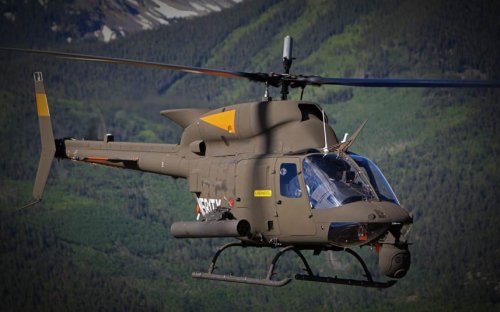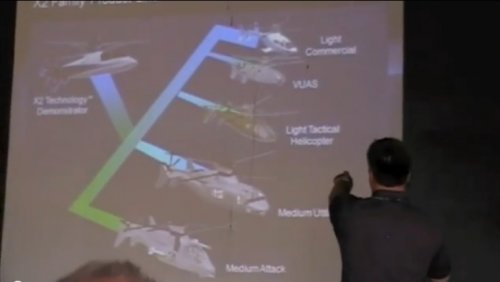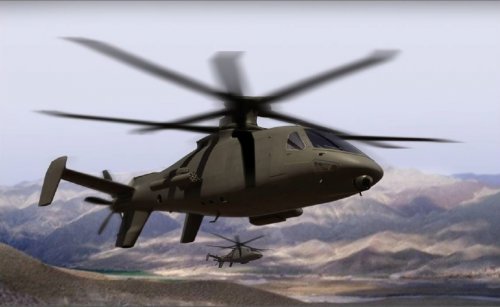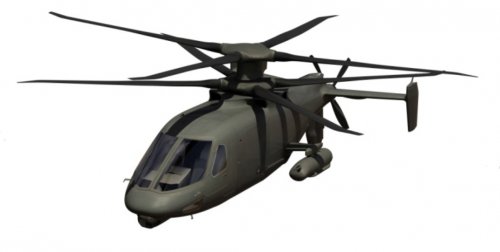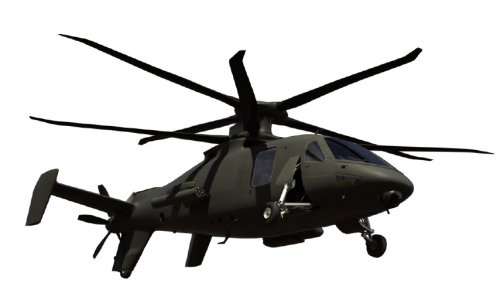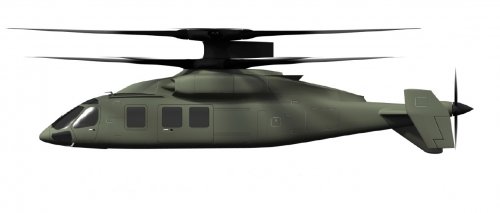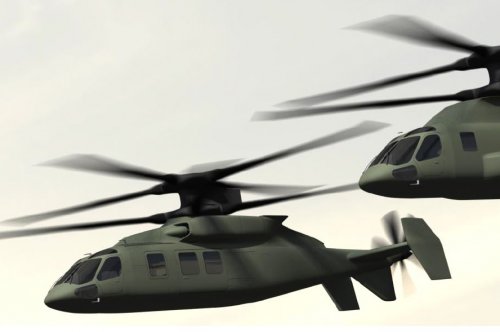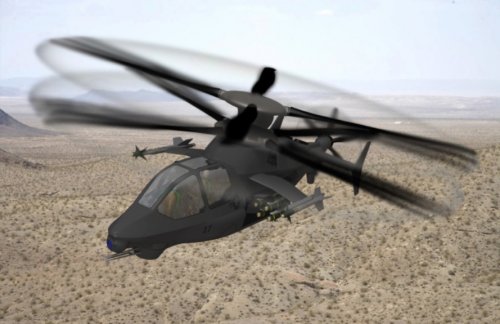Thanks for your analysis, yasotay.
You are using an out of date browser. It may not display this or other websites correctly.
You should upgrade or use an alternative browser.
You should upgrade or use an alternative browser.
Sikorsky X2 family
- Thread starter CammNut
- Start date
Sikorsky Aircraft press release:
"Sikorsky S-97 RAIDER(TM) Helicopter Enters Final Assembly with Delivery of the Fuselage from Aurora Flight Sciences"
Source:
http://online.wsj.com/article/PR-CO-20130926-910397.html
"Sikorsky S-97 RAIDER(TM) Helicopter Enters Final Assembly with Delivery of the Fuselage from Aurora Flight Sciences"
Source:
http://online.wsj.com/article/PR-CO-20130926-910397.html
STRATFORD, Conn., Sept. 26, 2013 /PRNewswire/ -- Sikorsky Aircraft Corp., a subsidiary of United Technologies Corp. (NYSE: UTX), this week begins final assembly of the prototype S-97 RAIDER(TM) helicopter following acceptance of the fuselage structure from Aurora Flight Sciences. Consisting of an integrated cockpit, cabin and tail cone, the composite fuselage arrived September 20 at Sikorsky's Development Flight Center in West Palm Beach, Fla., where the company will complete a light tactical rotorcraft designed to outmatch conventional military helicopters in speed, maneuverability, payload, range, and high altitude operations.
"The first fuselage marks a significant milestone for the industry-funded RAIDER helicopter program," said Debra Zampano, Sikorsky S-97 RAIDER Program Director. "Aurora has delivered an advanced composite aerostructure designed for our rapid development program. The Sikorsky team is now ready for final assembly of the prototype RAIDER aircraft. We look forward to showcasing the aircraft's exceptional performance and value to the U.S. military."
Sikorsky will convert the fuselage into a 36-foot-long, 11,000-lb.-gross weight S-97 RAIDER prototype aircraft. Configured to Sikorsky's X2(R) coaxial design, the fly-by-wire controlled helicopter will feature counter-rotating rigid main rotor blades for lift and forward flight, and a pusher propeller for high speed acceleration and deceleration.
Sikorsky proved the efficiency of the rigid rotor co-axial design in 2010 when its 6,000-lb. gross weight X2 demonstrator helicopter achieved 250 knot flight speed, or twice the speed of conventional helicopters. It also demonstrated low pilot workload and low acoustic signature.
The RAIDER prototype aircraft will improve on the X2 demonstrator by showcasing precision maneuvers in low flight speed, high G turning maneuvers at over 200 knots, hot day hover performance at altitudes up to 10,000 feet, and significant improvements in payload and flight endurance compared with conventional light tactical helicopters.
Aurora Flight Sciences is one of 36 industry teammates fabricating components for the Sikorsky-led RAIDER program. The mostly carbon fiber fuselage structure was fabricated at Aurora's manufacturing facility in Bridgeport, W. Va.
"The RAIDER fuselage was designed around a set of rigorous requirements necessary for this next-generation aircraft," said Aurora President and Chief Operating Officer Mark Cherry. "We applied our experience developing the composite main rotor pylon for the Sikorsky-built CH-53K heavy lift helicopter, and consequently our understanding of Sikorsky's design and manufacturing methodologies, to influence the RAIDER fuselage's preliminary and detailed designs, and subsequent development of the associated tooling."
From the start of conceptual design in late 2010, Sikorsky has pushed development of the S-97 RAIDER helicopter within a rapid timeline. Sikorsky intends to begin demonstrating the RAIDER helicopter's game-changing flight capabilities to the U.S. military and other potential customers in 2015.
"Sikorsky chose its teammates in 2011 based on their capability to deliver mature advanced technology products and systems," said Mark Miller, Sikorsky's Vice President of Research & Engineering. "Following completion of a system-level critical design review in early 2013, the entire RAIDER team has moved quickly into parts fabrication. We thank Aurora for delivering a fuselage on which we can build an aircraft with a generational leap in performance capability."
Sikorsky Aircraft Corp., based in Stratford, Conn., is a world leader in helicopter design, manufacture, and service. United Technologies Corp., based in Hartford, Conn., provides a broad range of high technology products and support services to the aerospace and building systems industries.
This press release contains forward-looking statements concerning opportunities for development, production and sale of helicopters. Actual results may differ materially from those projected as a result of certain risks and uncertainties, including but not limited to changes in government procurement priorities and practices, budget plans, availability of funding and in the type and number of aircraft required; challenges in the design, development, production and support of advanced technologies; as well as other risks and uncertainties, including but not limited to those detailed from time to time in United Technologies Corporation's Securities and Exchange Commission filings.
Follow Us on Twitter
Subscribe to RSS
SOURCE Sikorsky Aircraft Corporation
/CONTACT: Sikorsky media contacts: Marianne V. Heffernan, Phone: 203-386-4373, mheffernan@sikorsky.com, or Frans Jurgens, Phone: 203-386-6443, Frans.Jurgens@sikorsky.com; Aurora media contact: Patricia Woodside, Phone: (703) 396-6304, pwoodside@aurora.aero
- Joined
- 3 October 2007
- Messages
- 1,960
- Reaction score
- 1,197
S-97 may get a boost out of talked about plan changes at Army.
Although the S-97 was aimed at the AAS program, I think there was very little chance of it being selected. This is primarily because it isn't scheduled to fly until the end of 2014 and Army's announced date for downselect for AAS was in June. Given how little flight time the X2 demonstrator flew and how very little time it spent at its design speed, I just couldn't see Army being willing to bet on it for AAS.
Now the Army is talking about moving selection back two or more years. Whether that's due to lobbying by Sikorsky (ala Beech and AT-6 vs. A-29) or budget, that gives Sikorsky time to prove their concept. It also appears that Boeing is losing interest and EADS is taking a 2nd look at the US defense market. If they drop out that would leave Sikorsky, whatever Bell came up with (and AAS is a bit small for a Tilt-Rotor unless there were some special requirements like the original LHX spec) and maybe Karem. Not sure that MDD would even try.
Although the S-97 was aimed at the AAS program, I think there was very little chance of it being selected. This is primarily because it isn't scheduled to fly until the end of 2014 and Army's announced date for downselect for AAS was in June. Given how little flight time the X2 demonstrator flew and how very little time it spent at its design speed, I just couldn't see Army being willing to bet on it for AAS.
Now the Army is talking about moving selection back two or more years. Whether that's due to lobbying by Sikorsky (ala Beech and AT-6 vs. A-29) or budget, that gives Sikorsky time to prove their concept. It also appears that Boeing is losing interest and EADS is taking a 2nd look at the US defense market. If they drop out that would leave Sikorsky, whatever Bell came up with (and AAS is a bit small for a Tilt-Rotor unless there were some special requirements like the original LHX spec) and maybe Karem. Not sure that MDD would even try.
- Joined
- 18 October 2006
- Messages
- 4,211
- Reaction score
- 4,919
If the budget keeps going the way it is, I doubt the AAS effort will survive, unless Congressional delegations refuse to let the Army defund it. I doubt that will be the end of it though. The SOF community with new funding and congressional backing could get their first funded rotorcraft out of the S-97. Then there is the FVL-Light part of the future program. S-97 is likely the prime contender for that capability.
- Joined
- 3 October 2007
- Messages
- 1,960
- Reaction score
- 1,197
A question:
Looking at various S-97 specs and illustrations, including those by Sikorsky, conspicuous by its absence is overall height. Overall length is 37', rotor diameter is 34', width (sans rotor ) is 16', prop diameter is 7', but the height number, 8', is given only from the bottom of the sensor to the top of the cabin; not included is height off the ground, or height to the top of the mast or overall height.
Anyone know why that is and what the figures are gear up and gear down?
Looking at various S-97 specs and illustrations, including those by Sikorsky, conspicuous by its absence is overall height. Overall length is 37', rotor diameter is 34', width (sans rotor ) is 16', prop diameter is 7', but the height number, 8', is given only from the bottom of the sensor to the top of the cabin; not included is height off the ground, or height to the top of the mast or overall height.
Anyone know why that is and what the figures are gear up and gear down?
- Joined
- 3 October 2007
- Messages
- 1,960
- Reaction score
- 1,197
Triton said:Does this mean that the Army might proceed with Bell's OH-58F Block II proposal to upgrade existing Bell OH-58D Kiowa Warrior helicopters?
The Ds are to be rebuilt into Fs, that's already in the cards. Interstingly enough, the F was designed and the first three built by the Army itslef. The F was palnned to be around till 2025, but now they're talking 2030. Bell has proposed the Block II, which would be taking the Fs and adding a new engine, transmission and rotor systems, to get the required hot and high performance, along with condition based maintenance. At present that is not funded. I suspect that it would come to fruition if AAS is not delayed, but abandoned. Of course FVL light is still floating around out there, and its timeframe would fit in with the planned retirement date(s) of the 58F.
- Joined
- 3 October 2007
- Messages
- 1,960
- Reaction score
- 1,197
yasotay said:If the budget keeps going the way it is, I doubt the AAS effort will survive, unless Congressional delegations refuse to let the Army defund it. I doubt that will be the end of it though. The SOF community with new funding and congressional backing could get their first funded rotorcraft out of the S-97. Then there is the FVL-Light part of the future program. S-97 is likely the prime contender for that capability.
S-97 would be prime if Sikorsky wins JMR, since one of the primary goals of that program is to have a scalable technology that could support multiple sizes and missions of aircraft. If Sikorsky is not selected for one of the two flying demonstrtors, or whoever is picked after the flight tests, S-97 probably would not be a candidate for FVL light. Naturally, the same could be said for Bell, Karem and AVX.
Still, an enlarged S-97 type craft might be a candidate for MH-XX if USN decides whatever ends up being FVL doesn't meet their shipboard needs, assuming USN does want greater speed and range than current generation systems.
Could a rebuilt OH-58 be re-designated ARH-58 for Armed Reconnaissance Helicopter (ARH) as in the cancelled Bell ARH-70 Arapaho? It seems that the OH-58F Block II is retro-fitting the OH-58 to ARH-70 specs?
- Joined
- 18 October 2006
- Messages
- 4,211
- Reaction score
- 4,919
I think that the OH-58F is going to do that, assuming the funding remains in place for the upgrade. The Army has bought airframes to make up war attrition and if memory serves they actually had Bell build up some new cabins as well. Recall that the entire long sorted history of the Army Aero Scout effort was to overcome the shortcomings of the OH-58D, especially its short range and minimal high/hot capabilities.
Video of Bell OH-58D Kiowa Warrior replacement cabin program at Amarillo Production facility
http://youtu.be/cJNqplwC8xs
http://youtu.be/cJNqplwC8xs
Sikorsky has said in earlier briefings concerning X2 Technology that the technology is scalable and that the company intends to introduce the technology to the civil and general aviation markets. Are the speed and range increases of X2 Technology attractive to the civil and general aviation markets? Note the Sikorsky Light Commercial X2 concept in the upper right of this briefing screen shot. Cruise speed of 250 knots/288 mph/463 kmh?
Source:
http://www.youtube.com/watch?v=1lyIkxq-dnI&feature=youtu.be
Uploaded on Jul 25, 2011
Sikorsky test pilot Keven Bredenbeck describes the vehicles that may follow the X2, the company's newly-retired high-speed, coaxial-pusher combo that achieved a record-breaking speed of 250kt.
Source:
http://www.youtube.com/watch?v=1lyIkxq-dnI&feature=youtu.be
Attachments
- Joined
- 11 March 2006
- Messages
- 8,625
- Reaction score
- 3,804
With that cruising speed and considering, that in many countries it could land much closer to the
passengers actual destination, I think, it could take over flights from smaller turbo prop a/c, like
the KingAir or PC-12. That would mean a increase in comfort (just think of flights from the helipad
on a Skyscraper in city A to the helipad in city B,or from the flight deck of a yacht to the golf course
of the owners palace ... ;D ), but surely an increase in operating costs, too. But if the operating costs
of a X2 descendant are about in the range of conventional helicopters, it certainly would be attractive.
passengers actual destination, I think, it could take over flights from smaller turbo prop a/c, like
the KingAir or PC-12. That would mean a increase in comfort (just think of flights from the helipad
on a Skyscraper in city A to the helipad in city B,or from the flight deck of a yacht to the golf course
of the owners palace ... ;D ), but surely an increase in operating costs, too. But if the operating costs
of a X2 descendant are about in the range of conventional helicopters, it certainly would be attractive.
- Joined
- 3 October 2007
- Messages
- 1,960
- Reaction score
- 1,197
Triton said:Sikorsky has said in earlier briefings concerning X2 Technology that the technology is scalable and that the company intends to introduce the technology to the civil and general aviation markets. Are the speed and range increases of X2 Technology attractive to the civil and general aviation markets? Note the Sikorsky Light Commercial X2 concept in the upper right of this briefing screen shot. Cruise speed of 250 knots/288 mph/463 kmh?
Almost every manufacturer says almost every one of their concepts is scalable and will do everything they say. The particular value of the S-97 is that it will allow Sikorsky to demonstrate it in a practical sense, which is essential to get people serious interested. The X2 demonstrator had a total of 22 hours flight time, and maintained its high speed cruise for well less than 1/2 hour. EADS' X3 easily took the speed record away and has undergone demonstrations around the world with guest pilots and numerous pilot reports. Sikorsky needs to do that as well in order to attract investment money form notoriously conservative funding sources, and S-97's purpose is to do that.
FWIW, I think X3's main value is in civil, not military roles.
- Joined
- 3 October 2007
- Messages
- 1,960
- Reaction score
- 1,197
yasotay said:I think that the OH-58F is going to do that, assuming the funding remains in place for the upgrade. The Army has bought airframes to make up war attrition and if memory serves they actually had Bell build up some new cabins as well. Recall that the entire long sorted history of the Army Aero Scout effort was to overcome the shortcomings of the OH-58D, especially its short range and minimal high/hot capabilities.
One of the big things OH-58F Block II was to address was the hot and high issue you mention. Block II is a Bell proposal and they have been funding it themselves so far. In light of the AAS merry-go-round Bell has now stopped doing so, and if it is to go further the Army is going to have to come up with development money.
- Joined
- 3 October 2007
- Messages
- 1,960
- Reaction score
- 1,197
Jemiba said:With that cruising speed and considering, that in many countries it could land much closer to the
passengers actual destination, I think, it could take over flights from smaller turbo prop a/c, like
the KingAir or PC-12. That would mean a increase in comfort (just think of flights from the helipad
on a Skyscraper in city A to the helipad in city B,or from the flight deck of a yacht to the golf course
of the owners palace ... ;D ), but surely an increase in operating costs, too. But if the operating costs
of a X2 descendant are about in the range of conventional helicopters, it certainly would be attractive.
You are putting your finger on a big issue. X2 may or may not be more expensive to fly than a slower, comparably sized conventional helicopter, but it will certainly be more expensive than a fixed wing turboprop. It will not make many inroads there unless the regulatory, both local and federal, changes to allow for more operations closer to people's actual points of origin/destination, especially in urban This will be true for Tilt-Rotor or anything else, as well. This is what's been holding the rotorcraft industry back for decades. Why spend the money for a more expensive rotorcraft if you still have to operate from an airport or area not that close to your ultimate destination? How many central area public heliports are there in New York City or San Francisco, for example?
In fact, the building I am in right now has a helipad on the roof that was always and openly intended for public use by the owners. All the infrastructure for regular (as opposed to a emergency fire evacuation) use was put in place during construction. The city inspected all this as it was going on, advised on what they wanted and raised no objection and the FAA said it met the requirements and could certify it for regular public use. Upon completion of the building, the owners applied for their permit for use which they needed prior to getting FAA certification. The city denied the permit.
Unless this is overcome, it'll be hard to see big inroads in the existing General Aviation market.
- Joined
- 18 October 2006
- Messages
- 4,211
- Reaction score
- 4,919
Sadly this is true. The only thing that will overcome the famous FAA lethagy will be the economic factor that the major urban airports have little room to expand and billions of dollars are lost each year on the runways. Until the ecomonic pressures make Congress push the FAA bureaucrat to change things they won't.
- Joined
- 3 October 2007
- Messages
- 1,960
- Reaction score
- 1,197
yasotay said:Sadly this is true. The only thing that will overcome the famous FAA lethagy will be the economic factor that the major urban airports have little room to expand and billions of dollars are lost each year on the runways. Until the ecomonic pressures make Congress push the FAA bureaucrat to change things they won't.
It's an even bigger problem. There's all this talk of NextGen and WAAS, etc. but it's well known that the biggest and most cost effective way to increase airpsae capacity is to build more runways. FAA, though is shirking its responsibility in supporting airports that want to do that, making the fight against the NIMBYs and BANANAs difficult for airports that want to try, or even airports that are just trying to stay in business.
In a similar vein, it's not enough to say "heliports are OK with us". FAA needs to take a more active role in promoting their use and overcoming "formula" opposition. It jsut isn't doing that.
- Joined
- 3 October 2007
- Messages
- 1,960
- Reaction score
- 1,197
Triton said:Could a rebuilt OH-58 be re-designated ARH-58 for Armed Reconnaissance Helicopter (ARH) as in the cancelled Bell ARH-70 Arapaho? It seems that the OH-58F Block II is retro-fitting the OH-58 to ARH-70 specs?
ARH-70 was to be faster and weigh less, it was a further push than OH-58F Block II; would have cost more.
I presume that this Intermediate Commercial X2 concept would be of interest to the offshore helicopter transportation market of transporting personnel to and from offshore oil and gas production facilities.

F-14D said:ARH-70 was to be faster and weigh less, it was a further push than OH-58F Block II; would have cost more.
Thanks for the response and explanation.
- Joined
- 11 March 2006
- Messages
- 8,625
- Reaction score
- 3,804
Not sure that this branch of the air traffic business really is interested in spending more money just to bring pesonal fasterTriton said:I presume that this Intermediate Commercial X2 concept would be of interest to the offshore helicopter transportation market of transporting personnel to and from offshore oil and gas production facilities.
to and fro an oil rigg. Does half an hour really matter there, or rather low fuel burn and high transport capacity, to do with one
flight, what before needed two ?
The police and similar organisations won't be too interested, too. For loitering above a trafic jam high speed isn't really needed.
For quite a lot of tasks done with helicopters today, high speed actually isn't essential, so Sikorsky wil be producing a niche product,
I think. But of course, our overstressed and notoriously short of time politicians will be very happy about such an aircraft.
- Joined
- 3 October 2007
- Messages
- 1,960
- Reaction score
- 1,197
Jemiba said:Not sure that this branch of the air traffic business really is interested in spending more money just to bring pesonal fasterTriton said:I presume that this Intermediate Commercial X2 concept would be of interest to the offshore helicopter transportation market of transporting personnel to and from offshore oil and gas production facilities.
to and fro an oil rigg. Does half an hour really matter there, or rather low fuel burn and high transport capacity, to do with one
flight, what before needed two ?
The police and similar organisations won't be too interested, too. For loitering above a trafic jam high speed isn't really needed.
For quite a lot of tasks done with helicopters today, high speed actually isn't essential, so Sikorsky wil be producing a niche product,
I think. But of course, our overstressed and notoriously short of time politicians will be very happy about such an aircraft.
Oil companies are interested in high speed, up to a point. It's a matter of cost/benefit. Travel time is paid nonproductive time (and they are paid quite well), and comfort of the workers is also a factor. An aircraft ride can deliver crews to the rig able to go to work fairly soon, as opposed to arriving tired from a much longer boat trip, and if the sea is choppy, they'll be in better physical condition when they arrive at the rig or ashore. That's why there was so much movement to exchanging crews via helicopter rather than by boat. Of course, the fuel savings don't hurt, either (yes, helos actually use less fuel than boats).
That said, the air vehicle has to be properly sized. The companies are looking for something that can carry a passenger load somewhat approximating the size of crews/cargo to be exchanged. This is not unique, of course, the V-22 was sized around a Marine squad. Make the vehicle too big, and it's uneconomical, make it too small and you have other problems.
The latter exemplifies the mistake Bell made in sizing the 609 and expecting to get a lion's share of the offshore market once it was available. Compared with, say, the S-92, it could fly the round trip in half the time. Problem was, it carried half the number of passengers. So, overall the iteration took the same amount of time. I'm not sure about fuel, the 609 would burn less fuel than a comparably sized high speed VTOL, and probably less fuel than a conventional helo such as the S-92, but I don't know if it would be half.
As you mention, the cost penalty for X2 and also Tilt-Rotor probably would not be worth it for police and similar operations, although it would be a godsend for EMS, as long as the air traffic system could accommodate their advantages. For all the high speed concepts, they are only viable for missions where the majority of the flight is not spent hovering or at lower speeds.
Thanks, F-14D.
From AUSA Aviation Symposium & Exposition, Technology Development Panel, January 10, 2013 by Mark Miller, Vice President of Research & Engineering, Sikorsky Aircraft Corporation
Source:
http://www.ausaeventnotebook.com/
http://www.keepandshare.com/doc/5509351/mark-miller-pdf-10-9-meg?da=y
Source:
http://www.ausaeventnotebook.com/
http://www.keepandshare.com/doc/5509351/mark-miller-pdf-10-9-meg?da=y
Attachments
Possible replacement for the Bell AH-1Z Viper? I presume that this attack helicopter is too small to replace the Boeing AH-64 Apache.

- Joined
- 18 October 2006
- Messages
- 4,211
- Reaction score
- 4,919
If X-2 can have fuel economy like MV-22 (lbs/hr/mile) then I agree it would be a great escort. I do not think that an X2 can cruise at ~230 knots at a economical burn rate. I think pushing the rotor through the air is going to create a substantial burn rate for higher speed.
- Joined
- 3 October 2007
- Messages
- 1,960
- Reaction score
- 1,197
Triton said:Possible replacement for the Bell AH-1Z Viper? I presume that this attack helicopter is too small to replace the Boeing AH-64 Apache.
The AH-1Z and AH-64 are equivalent. In fact, before the ZuluCobra's development got slowed, the Z was actually more capable, but the latest Apaches just starting to come off the line are better in some things. The concept pictured is a variant of artists' concepts of an attack X2 Sikorsky has been showing for years. It looks smaller than Apache because for drag reasons a number of things that just "hang out" on the AH-64 have to be internal or retractable on this higher speed concept.
- Joined
- 3 October 2007
- Messages
- 1,960
- Reaction score
- 1,197
yasotay said:If X-2 can have fuel economy like MV-22 (lbs/hr/mile) then I agree it would be a great escort. I do not think that an X2 can cruise at ~230 knots at a economical burn rate. I think pushing the rotor through the air is going to create a substantial burn rate for higher speed.
Good point. The other issue is that it would require the V-22 to slow down since it cruises noticeably faster. The only V/STOL that can reasonably keep up with a Tilt-Rotor, other than a fixed wing, is another Tilt-Rotor.
F-14D said:The AH-1Z and AH-64 are equivalent. In fact, before the ZuluCobra's development got slowed, the Z was actually more capable, but the latest Apaches just starting to come off the line are better in some things. The concept pictured is a variant of artists' concepts of an attack X2 Sikorsky has been showing for years. It looks smaller than Apache because for drag reasons a number of things that just "hang out" on the AH-64 have to be internal or retractable on this higher speed concept.
Thank you for the additional information, F-14D.
Are there any issues with a tiltrotor attack platform with the transition from hover to forward flight and then back to hover?
Avimimus
ACCESS: Top Secret
- Joined
- 15 December 2007
- Messages
- 2,426
- Reaction score
- 907
To risk stating the obvious: Weapons have to be clear of the rotors and cleared for both release at speed and in a hover (if they are to be used at both). In past decades not all weapons (e.g. command or wire guided) were effective from a moving platform. Weapons like unguided rockets lose accuracy when fired from a hover etc.
The AH-64 has a much higher payload at its maximum range (at its maximum range the AH-1's warload is closer to an OH-58). I'm not sure how the armour/survivability situation currently stands.
F-14D said:Triton said:Possible replacement for the Bell AH-1Z Viper? I presume that this attack helicopter is too small to replace the Boeing AH-64 Apache.
The AH-1Z and AH-64 are equivalent. In fact, before the ZuluCobra's development got slowed, the Z was actually more capable, but the latest Apaches just starting to come off the line are better in some things. The concept pictured is a variant of artists' concepts of an attack X2 Sikorsky has been showing for years. It looks smaller than Apache because for drag reasons a number of things that just "hang out" on the AH-64 have to be internal or retractable on this higher speed concept.
The AH-64 has a much higher payload at its maximum range (at its maximum range the AH-1's warload is closer to an OH-58). I'm not sure how the armour/survivability situation currently stands.
- Joined
- 3 October 2007
- Messages
- 1,960
- Reaction score
- 1,197
Avimimus said:To risk stating the obvious: Weapons have to be clear of the rotors and cleared for both release at speed and in a hover (if they are to be used at both). In past decades not all weapons (e.g. command or wire guided) were effective from a moving platform. Weapons like unguided rockets lose accuracy when fired from a hover etc.
F-14D said:Triton said:Possible replacement for the Bell AH-1Z Viper? I presume that this attack helicopter is too small to replace the Boeing AH-64 Apache.
The AH-1Z and AH-64 are equivalent. In fact, before the ZuluCobra's development got slowed, the Z was actually more capable, but the latest Apaches just starting to come off the line are better in some things. The concept pictured is a variant of artists' concepts of an attack X2 Sikorsky has been showing for years. It looks smaller than Apache because for drag reasons a number of things that just "hang out" on the AH-64 have to be internal or retractable on this higher speed concept.
The AH-64 has a much higher payload at its maximum range (at its maximum range the AH-1's warload is closer to an OH-58). I'm not sure how the armour/survivability situation currently stands.
I've seen radius figures of ~130nm for the Z with a 2,500 lb. payload, and 260 for the AH-64, but the payload wasn't disclosed. Range is one of the Apache's advantages.
AH-1W has in the past had a lower combat loss rate than that of AH-64. Given that it had no armor or IR suppression, this was probably due more to tactics, training and less mechanical complexity. -!Z has armor and IR suppression, but it hasn't faced combat yet.
- Joined
- 3 October 2007
- Messages
- 1,960
- Reaction score
- 1,197
Triton said:Are there any issues with a tiltrotor attack platform with the transition from hover to forward flight and then back to hover?
Other than below a certain speed you have to be rotorborne and above a certain speed you need to be wingborne, I wouldn't think so. The range between the two is quite broad. There are no maneuvering limitations imposed by the transition, either way. As to how fast the proprotors translate, that's a function of design. For a transport like the V-22 there's no giant rush. For an attack platform, they might want the capability to do it faster, albeit not so fast that adverse effects occur. For example, you wouldn't want the proprotors to translate to airplane mode in one second if you're at 25 knots.
It would be interesting to see accel/decel projections for an attack X2 (bringing discussion back to topic) and an attack Tilt-Rotor.
Is fuel economy a selection criterion for the JMR/FVL program?
- Joined
- 3 October 2007
- Messages
- 1,960
- Reaction score
- 1,197
Triton said:Is fuel economy a selection criterion for the JMR/FVL program?
I would imagine it would be an evaluation consideration as part of the mix; all other things being equal, burning less fuel is better than burning more. I doubt if it's a go/no-go critera, though. If it was, I suspect the Tilt-Rotors would win automatically.
There is also the Advanced Concept Engine (ACE) program by the Army's Aviation Applied Technology Directorate (AATD) to develop a new 3,000 shp turboshaft engine that will offer "significantly improved" specific fuel consumption (sfc) and power-to-weight ratio.
Source:
http://www.aviationweek.com/Blogs.aspx?plckBlogId=Blog:27ec4a53-dcc8-42d0-bd3a-01329aef79a7&plckPostId=Blog%3A27ec4a53-dcc8-42d0-bd3a-01329aef79a7Post%3A91d49eee-e5d8-4734-a19b-4252f7c72b9a
Source:
http://www.aviationweek.com/Blogs.aspx?plckBlogId=Blog:27ec4a53-dcc8-42d0-bd3a-01329aef79a7&plckPostId=Blog%3A27ec4a53-dcc8-42d0-bd3a-01329aef79a7Post%3A91d49eee-e5d8-4734-a19b-4252f7c72b9a
I presumed that the design was an AH-Z Cobra replacement because the artist's impression seems to have a 20 mm (0.787 in) M197 3-barreled Gatling cannon in an A/A49E-7 turret rather than a 30 mm (1.18 in) M230 Chain Gun as used on the AH-64 Apache.
- Joined
- 18 October 2006
- Messages
- 4,211
- Reaction score
- 4,919
Given that military fuel cost far more than what even our friends in Europe have to pay at the pump. I cannot see a future aircraft that does not somehow take fuel economy into consideration. I have heard that fuel in Afghanistan is the equivalent of ~$400 per gallon. Certainly this takes into account all cost associated with getting that gallon to the aircraft. Still with competition for that gas going up, thus driving the cost per unit up, I cannot see cost conscious governments disregarding fuel economy as a criterion. I do not think it will be the paramount factor, but total operating cost will be a significant criterion. This is why the CEO for Bell is already campaigning for the US DoD to take total operating cost into account with the FVL program.
On the issue of X2 versus Tilt Rotor as an attack platform... it depends (in my opinion).
You want speed for three reasons: 1. Get there faster (your troops need help, enemy decision loop, you can get to the rearm/refuel faster a.k.a. retasking) 2. Bad guys have less time to shoot at you 3. wider area of operation for given unit of time. ADVANTAGE: Tilt rotor
You want agility: 1. maneuver (urban fight will be the 21st century jungle {electronic, thermal, human}, bring kinetic weapons to bear, avoid green or orange golf balls coming at you (i.e. tracers and the unseen round between them). Having once upon a time been a scout/attack helicopter pilot, getting around trees and buildings as well as out of the way of tracers is rather important. ADVANTAGE: X2.
There are of course many considerations that go into the decisions for a new military rotorcraft. "helicopter agility" with "high speed flight" with "fuel efficiency" will be tough.
If Yasotay were king for a day I would tell Sikorsky to make sure the S-97 was capable of carrying a decent war load for attack and reconnaissance missions, while telling Bell to make a utility TR that was not twice/three times the cost of a UH-60. That way I keep the politico's happy, have at least two major rotorcraft vendors to compete on the world market and yeah... probably get the right rotorcraft for the missions.
On the issue of X2 versus Tilt Rotor as an attack platform... it depends (in my opinion).
You want speed for three reasons: 1. Get there faster (your troops need help, enemy decision loop, you can get to the rearm/refuel faster a.k.a. retasking) 2. Bad guys have less time to shoot at you 3. wider area of operation for given unit of time. ADVANTAGE: Tilt rotor
You want agility: 1. maneuver (urban fight will be the 21st century jungle {electronic, thermal, human}, bring kinetic weapons to bear, avoid green or orange golf balls coming at you (i.e. tracers and the unseen round between them). Having once upon a time been a scout/attack helicopter pilot, getting around trees and buildings as well as out of the way of tracers is rather important. ADVANTAGE: X2.
There are of course many considerations that go into the decisions for a new military rotorcraft. "helicopter agility" with "high speed flight" with "fuel efficiency" will be tough.
If Yasotay were king for a day I would tell Sikorsky to make sure the S-97 was capable of carrying a decent war load for attack and reconnaissance missions, while telling Bell to make a utility TR that was not twice/three times the cost of a UH-60. That way I keep the politico's happy, have at least two major rotorcraft vendors to compete on the world market and yeah... probably get the right rotorcraft for the missions.
Similar threads
-
-
Sikorsky considers shuttering, selling light helicopter lines
- Started by Triton
- Replies: 48
-
-
Baldwin Technology Mono Tilt Rotor (MTR) and demonstrator (MTR-SD)
- Started by CammNut
- Replies: 1
-

